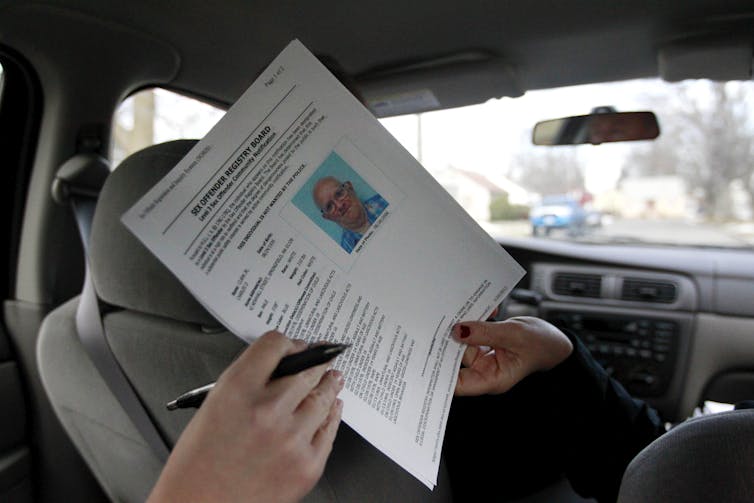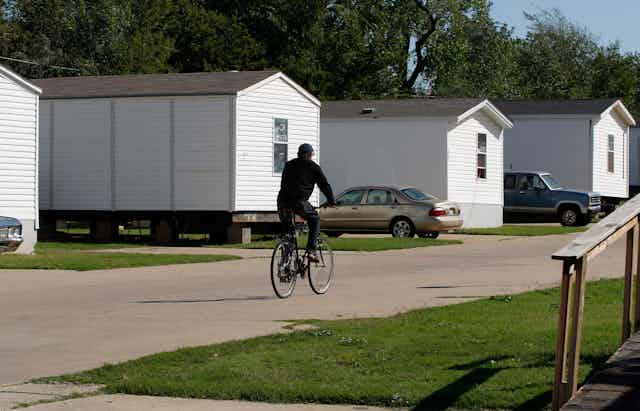Public sex offender registries are at the forefront of what I’ve described in my research as a “war on sex.”
Offenders convicted of sex crimes are now singled out for surveillance and restrictions far more punitive than those who commit other types of crime. More than 800,000 Americans are now registered sex offenders. Tracking them has created a booming surveillance industry.
In my work on sex offender registries, I have found that black men in the U.S. were registered at rates twice that of white men – resembling disparities found in the criminal justice system at large. However, these findings speak to the scope of the problem of American sex offender registries, as approximately 1 percent of black men in the U.S. are now registered sex offenders. My research suggests that inequality is deeply tied to sex offender policies.
Marked for life
Studies have found that rates in sex offender registration have ballooned more than 24 percent between 2005 and 2013. I wondered, is this in line with other trends in American corrections?
Data show it is not.
Although the U.S. still incarcerates far more people than any other country in the world, correctional supervision rates in the U.S. (including people in jail or prison as well as those on parole or probation) peaked in 2007 and have been declining since, albeit at a molasses pace. That means sex offender registries have grown while the prison population has shrunk.
Imagine being punished for something you did three decades ago. You served your time and thought it was in the past. Under American sex offender laws, moving on is nearly impossible: Most state policies are retroactive, meaning they apply to offenders who committed offenses before these laws were put in place. While these laws are the subject of several ongoing court battles, most remain in effect.

Offenders are subject to extensive public notification requirements, which include state-run search engine listings that feature their address, mugshot, criminal history and demographic information. In some cases, offenders are also required to publicly post flyers with their pictures or run newspaper notices advertising their residency. Some states, such as Louisiana, stamp “SEX OFFENDER” in large red script on driver’s licenses.
Having a mugshot disseminated across internet search engines is only the tip of the iceberg; once registered, offenders are subject to a wide array of housing and employment restrictions.
In many places in the U.S., sex offenders are effectively zoned out of cities and towns because there are no residential areas that satisfy all of the numerous regulations. For example, offenders may be prohibited from living within a certain number of feet from a playground.
They are often left with no choice but to live under highways or in improvised communities, such as the one in Pahokee, Florida depicted in the New York Times 2013 short film, “Sex Offender Village.”
Why have registries?
Punishment scholar Jonathan Simon argues that the rise of sex offender registries is the result of lawmakers’ efforts to “govern through crime.” In other words, today’s lawmakers assert their authority by enforcing order and promoting fear of crime. This approach differs from, say, politicians who secure authority by promoting a social welfare agenda and social safety net.
Lawmakers offer a different explanation. They argue that more invasive policies are necessary because sex offenders are highly likely to commit future crimes. In their view, informing the public of their criminal history will offer protection. But as the U.S. federal government’s Office of Sex Offender Sentencing, Monitoring, Apprehending, Registering and Tracking notes, sex offender registration requirements “have been implemented in the absence of empirical evidence regarding their effectiveness.”
Now that all 50 U.S. states and Washington, D.C. have developed such registries, the evidence testing the effectiveness of sex offender registries is beginning to mount. It is mixed, at best.
Do registries work?
One study followed sex offenders who were labeled “high-risk” for reoffending and who were released from Wisconsin prisons in the late 1990s. That study compared offenders who were subjected to limited public notification requirements with those who were subjected to extensive requirements. The researchers found no significant difference in the average time between release and a future offense. In other words, extensive public notification did not deter future offenses.
However, another study evaluated the likelihood of reoffending for sexual offenders labeled “high risk” released from Minnesota state correctional facilities. Here researchers found that offenders subject to community notification were somewhat less likely to commit another sexual offense.
Finally, a recent study found that sex offenders released in Florida between 1990 and 2010 had lower rates of recidivism than offenders of other types of crime – 6.5 percent for sex offenses, as compared to 8.3 percent for nonsexual assaults and 29.8 percent for drug offenses. Moreover, that study found that recidivism rates increased after the state legislature implemented sex offender registration requirements in 1997.
While the evidence is mixed that these policies are effective at deterring crime, the evidence of their collateral consequences is more consistent. Several studies of registered sex offenders have revealed how registries reinforce class inequality by creating patterned experiences of unemployment, harassment and homelessness.
From a public safety perspective, scholars note that registries provide the public with a false sense of security: While the existence of sex offender registries reinforces a myth of “stranger danger,” most offenders in reality are acquaintances or family members. Balancing the thin support of the registries’ effectiveness against the more robust evidence of their negative effects, one scholar recently concluded these policies do more harm than good.
My research suggests there is also a racialized dimension to the war on sex offenders that complicates arguments in their favor. The evidence does not strongly suggest registries are effective at deterring crime. Rather, their most lasting impact may be their exacerbation of inequalities based on race, class and gender.

